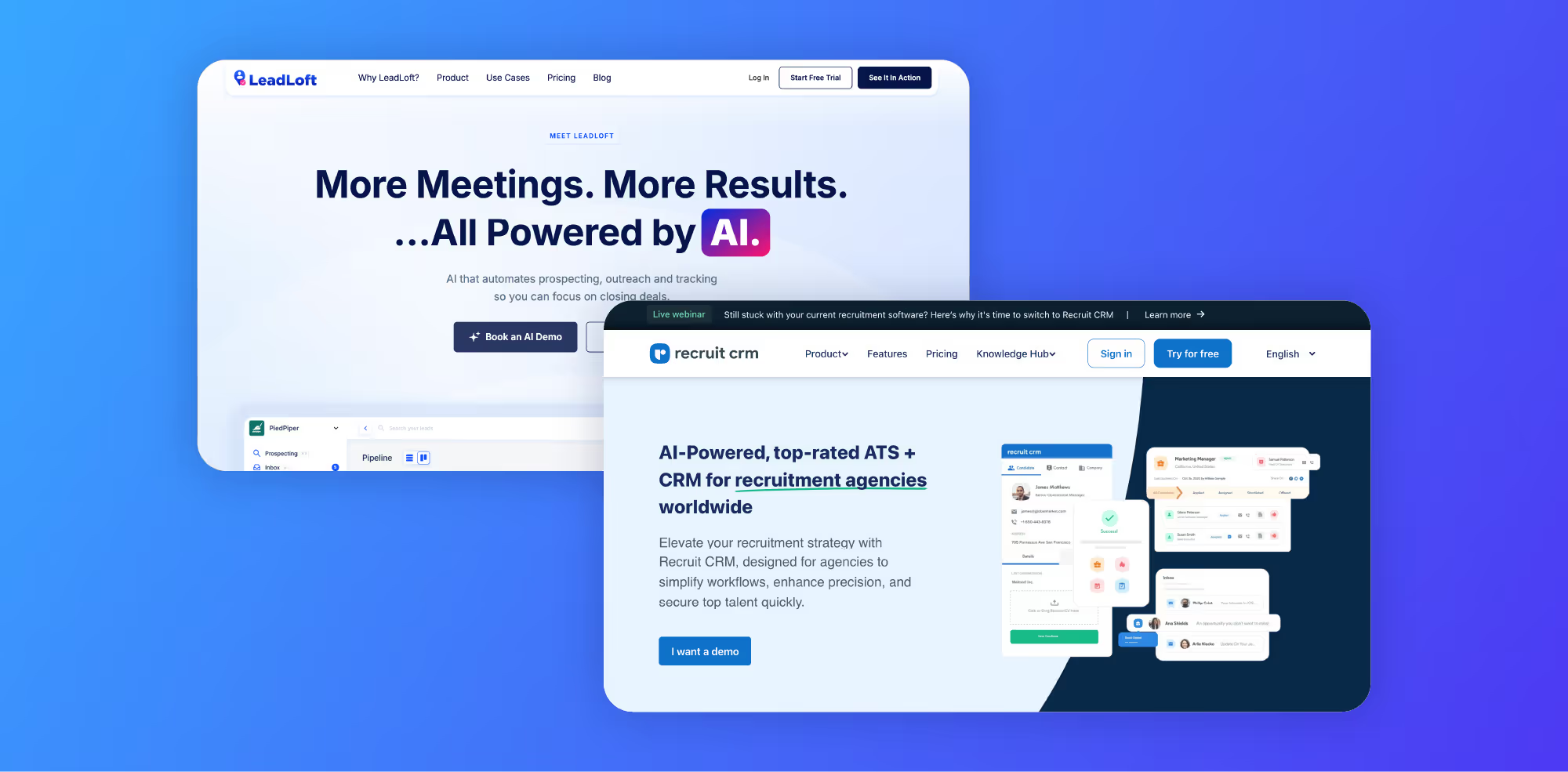Recruiting today isn’t just posting job ads and collecting resumes. The best CRMs combine sourcing from networks like LinkedIn, candidate relationship & engagement, communication sync, automation, and ways to manage pipelines and hiring workflows.
If you’re choosing a tool in 2025, LinkedIn integration and automation are major differentiators. Here are several tools that stand out: what they do well, where they may lag, and what kind of recruiting team they are best for.
Recruit CRM
Website: recruitcrm.io
Main Pricing: Around $40–$65 per user/month (depending on plan) for most of the core recruiting + ATS + CRM features.
What It Offers & LinkedIn Features:
Recruit CRM is built for recruiters & staffing agencies. It includes sourcing tools (resume parsing, job board integrations), candidate tracking pipelines, communication & email automation, and advanced analytics.
For LinkedIn, it supports:
- Chrome sourcing extension: pull candidate profiles from LinkedIn directly into the CRM.
- Messaging integration so you can see LinkedIn conversations with candidates inside the CRM.
- Workflow automation for outreach follow-ups and nurturing.
Pros:
- Very recruiting-centric: handles interviews, candidate feedback, pipelines, and CRM for client/agency side.
- Strong LinkedIn integration tools (sourcing + messaging) reduce context switching.
- Good analytics & automation so recruiters don’t miss follow-ups.
Cons:
- Some advanced features (e.g., resume builders, SMS, or scorecards) are locked behind higher plans.
- Pricing is higher than basic recruiting CRMs, may be overkill for occasional hiring.
- Depending on plan, free job board access and customizations may be limited.
Best For:
Recruitment agencies or in-house teams that recruit frequently, need to manage large candidate volumes, want heavier LinkedIn usage (sourcing + messaging), and care about detailed pipelines & analytics.
LeadLoft
Website: leadloft.com
Main Pricing: $99/user/month for their core “Unlimited” plan that unlocks outreach, LinkedIn automation, prospecting, etc.
What It Offers & LinkedIn Features:
LeadLoft has expanded toward recruiting. Some of its strengths:
- Prospect candidates via email, LinkedIn, phone, and tasks.
- LinkedIn scraper, automation for outreach (including messages), and follow-ups.
- “Automated recruiting” features: describe your ideal candidate, then let the system help find, outreach, and manage them.
- Message sync lets you see LinkedIn messages in your pipeline.
Pros:
- Very strong when LinkedIn is a major channel: great for automating candidate outreach & engagement.
- AI-powered prospecting & enrichment reduces manual sourcing.
- Unified pipeline and outreach workflow across channels (LinkedIn + email) is efficient.
Cons:
- Not a “pure” ATS: job board multiposting or interview scheduling is less mature.
- At $99, cost is higher for smaller recruiting teams or light hiring.
- LinkedIn’s platform limits (invites/messages per day) still apply.
Best For:
Teams who recruit often, especially when many candidates are passive or must be sourced via LinkedIn, and when outreach + follow-ups are critical.
Manatal
Website: manatal.com
Main Pricing: Entry-level around $15/user/month for basic plans.
What It Offers & LinkedIn Features:
Manatal combines ATS + CRM functionality with:
- Job management, candidate pipelines, and job board integrations.
- Chrome extension for sourcing candidates via LinkedIn.
- AI recommendations to match candidates with job descriptions.
Pros:
- Very strong value for cost, especially for smaller teams.
- Easy LinkedIn sourcing, pipeline building, and tracking.
- User-friendly interface with a low barrier to entry.
Cons:
- Fewer advanced features than higher-end systems: custom reporting, enterprise-scale posting.
- Some features require add-ons or higher tiers.
- May need third-party integrations as teams grow.
Best For:
Smaller recruitment teams, agencies, or internal talent acquisition functions with modest volume who still need strong LinkedIn sourcing without high costs.
Recruiterflow
Website: recruiterflow.com
Main Pricing: Around $99/user/month for their base recruiting CRM/ATS plan.
LinkedIn & Key Features:
- Pipeline view for candidates with drag & drop stages.
- Task automation, reminders, and follow-ups.
- Integrations with job boards.
- Supports LinkedIn sourcing, though messaging integration is less advanced than tools like LeadLoft.
Pros:
- Good mix of pipeline management and recruiting features.
- Solid for agencies or internal recruiters who need structure & automation.
- Balanced feature set, less overwhelming than some enterprise ATS.
Cons:
- Higher cost compared to entry-level systems.
- Some advanced integrations need configuration or add-ons.
- LinkedIn automations not as strong as specialized outreach tools.
Best For:
Teams that want a strong CRM + ATS combo with enough automation to reduce manual work, while keeping clarity in tracking many roles/candidates.
Other Mentions
- LinkedIn Recruiter (and Recruiter Lite): unmatched for passive candidate discovery, but often needs a complementary CRM/ATS.
- HireEZ (formerly Hiretual): great for multi-channel sourcing, AI-driven recommendations, and passive talent search.
Final Thoughts: What to Prioritize
Here’s what matters most when choosing a recruiting CRM in 2025, especially if LinkedIn use is high:
- Sourcing + LinkedIn integration: ability to import profiles, sync messages, capture data.
- Outreach & engagement automation: follow-ups, reminders, templates, message automation (within LinkedIn’s policies).
- Pipeline & ATS features: interview scheduling, candidate tracking, resume parsing.
- Analytics & reporting: measure time-to-hire, outreach effectiveness, and pipeline health.
Top Picks by Use Case:
- Recruit CRM: most balanced ATS/CRM with LinkedIn tools, strong pipelines, and communication features.
- LeadLoft: best if recruiting relies heavily on LinkedIn outreach and automation.
- Manatal: best cost/value for smaller teams starting to scale with LinkedIn sourcing needs.


